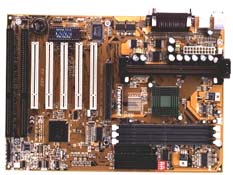Transcend TS-ABX i440BX ATX Slot-1
by Mike Andrawes on June 19, 1999 11:53 PM EST- Posted in
- Motherboards
You may not have heard of Transcend, but they have been around quite a while - at least compared to others in the motherboard industry. Founded in 1988, they focus solely on the manufacture of high quality memory and motherboard products - an interesting combination that is not too common. Nevertheless, they make it very clear that they want to be "Your Supplier, Your Partner, and Your Friend" - that's their motto. Let's see if what kind of job they can do in the extremely competitive motherboard market.
New Anand Tech Report Card Rating 87/B
Do not compare newer ratings to older ones, the newer ratings are much more aggressive
| CPU Interface | Slot-1 |
| Chipset | Intel i440BX |
| L2 Cache | N/A (on-chip) |
| Form Factor | ATX |
| Bus Speeds |
66 / 68 / 75 /
83 |
| Clock Multipliers | 3.5x - 8x |
| Voltages Supported | Auto Detect |
| Memory Slots | 3 168pin DIMM Slots |
| Expansion Slots |
1 AGP Slot |
| BIOS | Award 4.51PG |
The Good
Transcend's most popular board, at least among AnandTech readers, will probably be the i440BX based TS-ABX. The first impression of the board is that it's a cross between the Abit BH6's brown PCB/layout and the AOpen AX6BC's build quality.
Transcend also wisely chose a 5/2/1 (PCI/ISA/AGP) slot configuration that is by far and away the most popular on newer i440BX boards. The typical 3 DIMM slots are included as well. The ATX specification is followed fairly closely in terms of layout, with just one minor change - the ATX power connector is located behind the CPU. Fortunately, it is placed on the right edge of the board, but this is still not an ideal location. The FDD/HDD connectors are located where they should be, right at the front of the board, so that these cables are not forced to run over the CPU and/or memory, minimizing cable clutter. The board extends an inch and a half beyond the ISA slots, so it should fit fine in any standard ATX case.
Ten beefy 1500uF capacitors surround the CPU slot. A few smaller ones are spread out around the board, but just a very few. Three 3 pin fan connectors are available for using monitored fans - one by the CPU slot, one by the DIMM slots, and one right in front of the ISA slots. A fold down universal retention kit is installed on the board at the factory and will hold any Celeron, Pentium II, or Pentium III CPU securely in place. High quality Foxconn connectors are used throughout the board.
Following in the footsteps of the the AOpen AX6BC and Abit BX6 Revision 2, Transcend has included a full complement of FSB speeds - 66 / 68 / 75 / 83 / 100 / 103 / 112 / 117 / 124 / 129 / 133 / 138 / 143 / 148 / 153 are all available from Transcend's own partially jumperless CPU setup found under Chipset Features Setup. All FSB speeds that need it are available with and without a 1/4 PCI multiplier. That PCI bus speed is very clearly indicated next to each FSB speed. Settings below 100MHz are only available when the 66/100MHz jumper is set for 66MHz operation. Similarly, those above 100MHz are only available when the board is configured for 100MHz operation. Note that Transcend also sells a version of the board without all these bus speeds available.
A DIP switch bank on the board controls multiplier settings. As Transcend points out in the manual, the setting of clock multiplier's is virtually useless for new CPU's since Intel has implemented multiplier locking. However, it is of course necessary for older CPU's that are not locked. Stability in non-overclocked situations was excellent, most likely due to the high quality design of the board and components used. Stability was somewhat compromised while overclocking, but it was still well above average. Performance was about average for an i440BX, which is not a bad thing in this market segment where virtually everyone performs within 5% of each other.











0 Comments
View All Comments